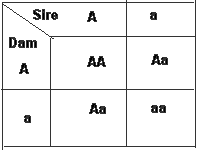Many canine afflictions have been determined to be simply recessive traits. Some of these are PRA in Irish Setters and collies and CMO in some terriers. Additionally, dwarfism is thought to be an autosomal recessive trait in Great Pyrenees. To conclusively prove this theory, it would be necessary to breed two affected (dwarf) animals. To date, several attempts to perform this breeding have failed. It is thought that perhaps the dwarfs have infertility issues, especially the bitches, but that also is yet to be proved. regardless, all breeding data continues to indicate that dwarfism is an autosomal recessive.
This article will address only the statistical consequences of certain mating examples. The ethics of breeding will be left to the reader. My goal is only to add one more tool to your breeder "toolbox" by giving some finite numbers to contrast with what many breeders prefer to leave to guesswork.
I will only address inherited abnormalities that are considered to be autosomal recessive, or genetic defects that are carried by one single gene (e.g. dwarfism). Polygenetic characteristics (i.e. OCD, HD) are not applicable to these examples.
 This simple table illustrates the cross of two heterozygous parents, defined as "Aa". "A" represents the normal gene and "a" represents the defective gene. If the graphic were to represent a litter of four puppies by these parents, we would visually see three "normal" progeny illustrated by the "AA" and "Aa" and one defective progeny, "aa". The "AA" pup is phenotypically normal AND genetically normal, since he does not possess the defective "a" gene. Unfortunately, the "AA" animal would look no different that its "Aa" siblings, although the "Aa" animals are genetic carriers. We use this information to state the following:
This simple table illustrates the cross of two heterozygous parents, defined as "Aa". "A" represents the normal gene and "a" represents the defective gene. If the graphic were to represent a litter of four puppies by these parents, we would visually see three "normal" progeny illustrated by the "AA" and "Aa" and one defective progeny, "aa". The "AA" pup is phenotypically normal AND genetically normal, since he does not possess the defective "a" gene. Unfortunately, the "AA" animal would look no different that its "Aa" siblings, although the "Aa" animals are genetic carriers. We use this information to state the following:
In a coin toss, there are two possible outcomes, but they both have equal probability o f occurring or 50 percent probability. Therefore, to calculate the probability of "heads" on ONE toss, it is ½ or 50 percent. The probability of heads on two consecutive tosses is ½ x ½ or 25 percent; three tosses is ½ x ½ x ½ or 12.5 percent and so on.
For our breeding example, we know that if both parents are carriers, any one potential offspring has a 25 percent probability of being defective and 75 percent probability of being normal. Using that information, we can say that if there is ONE offspring that is phenotypically normal, the unknown parent has a ¾ or 75 percent chance of being a carrier. Additionally, two normal offspring give the unknown parent a ¾ x ¾ of 56.3 percent chance, and so on.
The formula used to derive this probability table is Bayes Law of Probability, and can be illustrated by the following :

It is also possible to test-breed two parents of unknown carrier status if the history of the pedigree is known. Using statistical tools, the status of the puppies can be statistically determined. this calculation will be outside the scope of this article, but the author can answer questions regarding this possibility.
Depending on the size of a litter, one may make statistical assumptions of the sire or dam. If no defective puppies are produced in test breeding, the litter size will make it possible to determine the probability of the unknown parent being a carrier of the defective gene. In Table 1, we show the probability of the unknown parent being a carrier. If an affected puppy is born, then we know that both parents are carriers for that trait. As you can see, it would take a substantial number of puppies to show the parent to be a non-carrier with high probability
| # of Normal Pups |
# of Affected Pups |
Probability of Being a Carrier |
Probability of NOT Being a Carrier |
| Any number 1 2 3 4 5 6 7 8 9 10 11 12 13 14 15 |
1 or greater 0 0 0 0 0 0 0 0 0 0 0 0 0 0 0 |
100% 75% 56.3% 42.2% 31.6% 23.7% 17.8% 13.3% 10.0% 7.5% 5.65% 4.2% 3.2% 2.4% 1.8% 1.3% |
0% 25% 43.8% 57.8% 68.4% 76.3% 82.2% 86.7% 90.0% 92.5% 94.4% 95.8% 96.8% 97.6% 98.2% 98.7% |
Genetic marker testing is gaining popularity. It is becoming financially and technologically feasible to do DNA marker tests. Unfortunately, one of the only marker tests currently available for an autosomal recessive trait is PRA in Irish Setters. The Great Pyrenees Club of America is currently mounting an effort to develop a DNA test screen for dwarfism in cooperation with the University of California at Berkeley. In order for this study to be successful, Great Pyrenees breeders must support the study with genetic pedigree and DNA data. Genetic studies of this magnitude need sample (i.e., blood, saliva or tissue) and family pedigree information.
or of the Dwarfism Study
Mary Beth Vaudrin
TamraGreen
Tamra Green, the author, is the lead committee member for the GPCA genetic dwarfism study and a member of the GPCA Health Committee. This article first appeared in the GPCA Bulletin, Sept/Oct 2000 , is copyrighted by the author and used here with permission.